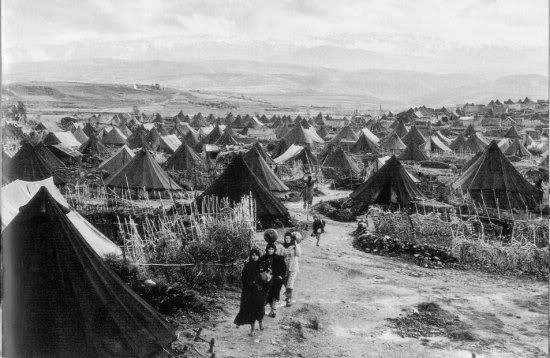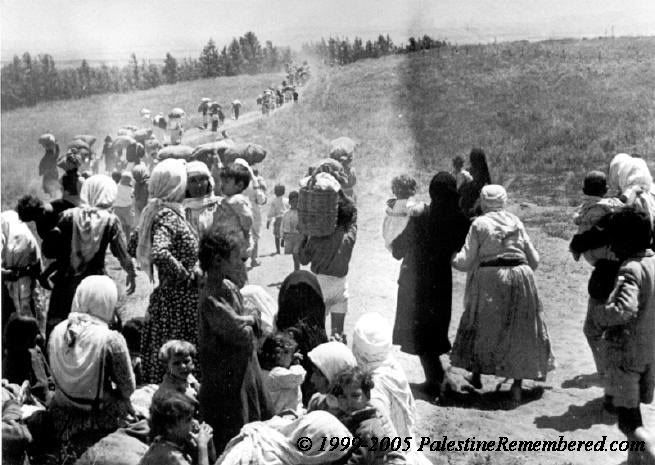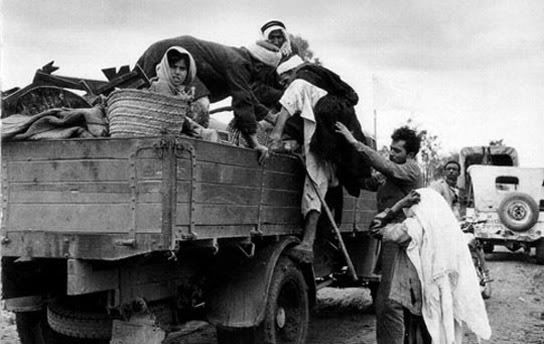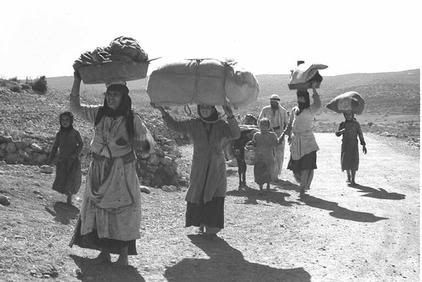….is an oxymoron.
Roughly interpreted as the “catastrophe” in Arabic, it is the day Palestinians living in Israel, the Occupied Palestinian Territories, refugee camps around the Middle East, and wherever they live around the world commemorate as the day they lost their ancestral home in original Palestine. Many people, including Jewish Israelis, Jews living around the world, and non-Jews are ignorant of the Nakba, and the history that preceded and followed the birth of Israel. The day on which the Nakba is remembered is the day Palestinians think about the roughly 800,000 Palestinians who were ethnically cleansed from original Palestine, their homeland for over a thousand years. March 10 is significant for another reason: it is the date their demise was planned.
The Institute for Middle East Understanding (IMEU) recently announced that the Israeli founder of Zochrot, Hebrew for “Remembering,” Eitan Bronstein, along with Muhammad Jaradat of the Badil Resource Center for Palestinian Residency and Refugees’ Rights, will be on a speaking tour in the U.S. from March 25-April 7. Eitan Bronstein has worked for years to tell the story many do not believe. He founded Zochrot in order to educate people of the truth and to raise awareness among Israelis about the Nakba, or “Catastrophe.”
“When it comes to the Nakba and what was there before Israel was created, it’s a big hole, a black hole and people don’t know how to deal with it,” he said. “It’s perhaps the most important period of our life in this region and it’s not really known.”
As an introduction, IMEU reported that last week, Israeli Defense Minister Ehud Barak sought legal opinions on the possibility of expelling Palestinian civilians from northern Gaza. They note that attempts to drive Palestinians out of their homes and homeland actually began in earnest 60 years ago today. Zionist leaders met in Tel Aviv on March 10, 1948 and adopted a plan to expel as many Palestinians as possible from their homes before and immediately after Israel declared independence on May 14.
Here is the reality that remains hidden from view. March 10 marks the date on which Plan Dalet was adopted.
1. What is Plan Dalet?
Sixty years ago today Zionist political and military leaders met at the “Red House” in Tel Aviv and agreed to Plan Dalet, which called for the systematic expulsion of Palestinians from areas sought for the soon-to-be-founded state of Israel. The plan led to what Palestinians refer to as the Nakba.
At that time, Jews owned only about seven percent of the land in Palestine and constituted about 33 percent of the population. The Palestinians’ presence and predominant ownership of the land were obstacles to the creation of a Jewish state. Moshe Sharett, Israel’s second prime minister, said “We have forgotten that we have not come to an empty land to inherit it, but we have come to conquer a country from people inhabiting it.”
2. Who devised Plan Dalet?
Top leaders of the Haganah, the leading Zionist underground militia in Palestine at the time, formulated Plan Dalet. One of the key instigators was David Ben-Gurion, who became Israel’s first prime minister. A long-time proponent of expelling the Palestinians, 10 years earlier he stated to the Jewish Agency Executive, “I am for compulsory transfer; I do not see anything immoral in it.”
3. When was Plan Dalet implemented?
Israel has since claimed that it was attacked by surrounding Arab states immediately after its founding on May 14, 1948, and that refugees fled due to the ensuing conflict. In fact, Plan Dalet predated the entrance of the Arab states into war with Israel. Some 250,000 Palestinians were expelled in the two months between the March 10 adoption of Plan Dalet and the establishment of Israel in mid-May. The stream of refugees into the Arab states created pressure on them to intervene to stanch the flow. It is more accurate to say that the refugee flight caused Arab intervention than the other way around.
4. What resulted from Plan Dalet?
Plan Dalet led to the depopulation of at least 450 Palestinian towns and villages, most of which were demolished to prevent the return of the refugees. By the end of 1948, more than 700,000 Palestinians – two-thirds of the Palestinian population – were exiled. It is estimated that more than 50 percent fled under direct military assault. Others fled in panic as news of massacres spread – for example, more than 100 civilians killed in the village of Deir Yassin on April 9 and 200 in Tantura between May 22nd and 23rd.
5. Why is Plan Dalet relevant today?
Israel will commemorate its 60th anniversary this May without acknowledging the ethnic cleansing and dispossession of Palestinians it perpetrated. At the same time, Palestinians will mark their dispossession and remind the world of their right to return to their homeland. An overwhelming majority of Palestinians believes that refugee rights must be remedied for peace between Palestinians and Israelis to endure.
Plan Dalet led to the Nakba or “Catastrophe.”
Ten Facts about the Nakba
1.The Nakba is a root cause of the Israeli/Palestinian problem.
It is marked on May 14, the date on which Israel declared its independence in 1948.
2. This traumatic event created the Palestinian refugee crisis.
By the end of 1948, two-thirds of the Palestinian population was exiled. It is estimated that more than 50% were driven out under direct military assault. Others fled as news spread of massacres committed by Jewish militias in Palestinian villages like Deir Yassin and Tantura.
3. Jewish leaders saw “transfer” as an important step in the establishment of Israel.
Jewish leaders spoke openly of the need to use military clashes to expel as many Palestinians as possible before other Arab countries could come to their defense. The Haganah militia’s Plan Dalet was the blueprint for this ethnic cleansing. Israel’s first Prime Minister, David Ben Gurion, said “We must use terror, assassination, intimidation, land confiscation, and the cutting of all social services to rid the Galilee of its Arab population.” (See what other leading Israelis have said about transfer.)
4. Hundreds of Palestinian villages and towns were destroyed.
Jewish forces depopulated more than 450 Palestinian towns and villages, most of which were demolished.
5. Palestinian property and belongings were simply taken.
The newly established Israeli government confiscated refugee land and properties without respect to Palestinian rights or desires to return to their homes.
Israeli historian Tom Segev reported that: “Entire cities and hundreds of villages left empty were repopulated with new [Jewish] immigrants… Free people – Arabs – had gone into exile and become destitute refugees; destitute refugees – Jews – took the exiles’ places in the first step in their lives as free people. One group [Palestinians] lost all they had while the other [Jews] found everything they needed – tables, chairs, closets, pots, pans, plates, sometimes clothes, family albums, books radios, pets….
6. Some Palestinians stayed in what became Israel.
While most Palestinians were driven out, some remained in what became Israel. Although citizens of the new state, they were subject to Israeli military rule until 1966. Today, Palestinian citizens of Israel comprise nearly 20 percent of Israel’s population. They have the right to vote and run for office, but more than 20 Israeli laws explicitly privilege Jews over non-Jews. Nearly one-quarter of Israel’s Palestinians are “internally displaced” persons, unable to return to the homes and lands that were taken from them.
7. There are still millions of Palestinian refugees dispersed around the world.
Today, there are 4.4 million Palestinian refugees registered as such with the United Nations, and at least another estimated 1 million who are not so registered. Thus a majority of the Palestinian people, around 10 million persons, are refugees.
8. Refugees have internationally-recognized rights.
All refugees enjoy internationally-recognized rights to return to areas from which they have fled or were forced out, to receive compensation for damages, and to either regain their properties or receive compensation and support for voluntary resettlement. This right has been explicitly acknowledged in recent peace agreements in Cambodia, Rwanda, Croatia, Bosnia-Herzegovina, Guatemala, Northern Ireland, Kosovo, Sierra Leone, Burundi, and Darfur. This right was affirmed for the Palestinians by the United Nations Resolution 194 of 1948. Israel, however, does not allow Palestinian refugees to return, although a Jew from anywhere in the world can settle in Israel.
9. Justly resolving refugee rights is essential to Middle East peace.
An overwhelming majority of Palestinians believes that refugee rights must be fulfilled for peace between Palestinians and Israelis to endure. And according to an August 2007 poll by the Jerusalem Media and Communications Center, nearly 70 percent believe that refugees should be allowed to return to “their original land”.
10. The Nakba has implications for Americans.
Israel’s ongoing denial of Palestinian rights – and unconditional U.S. financial and diplomatic support for Israel – fuels anti-American sentiment abroad. A 2002 Zogby poll, conducted in eight Arab countries showed that “the negative perception of the United States is based on American policies, not a dislike of the West.” The same poll showed that “the Palestinian issue was listed by many Arabs among the political issues that affect them most personally.” Resolution of the Palestinian refugee issue would undoubtedly improve America’s international image, by proving that the U.S. government supports the consistent application of international law.
This link will take you to meet Palestinians who lived through the Nakba and recount its details and explain its relevance to Americans.

Palestinian women walk through the Nahr el-Bared refugee camp in Lebanon in 1951. (UNRWA)







